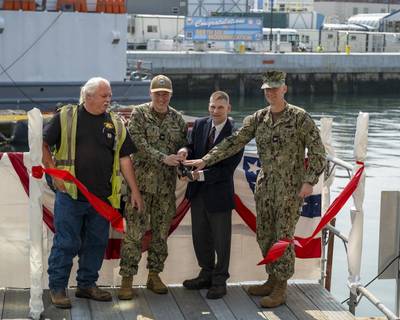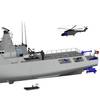US Navy Opens Upgraded Berth at Portsmouth Naval Shipyard
U.S. Navy leadership held a ribbon-cutting ceremony on July 30 to celebrate the modernization of Berth 6 at Portsmouth Naval Shipyard. The $35 million project marks a milestone in the ongoing Shipyard Infrastructure Optimization Program (SIOP), aimed at upgrading facilities to support the Virginia and Los Angeles-class submarines.
Originally constructed in 1903, Berth 6 has undergone extensive repairs and upgrades to its dockside utility services. Enhancements include a fenced electrical substation yard, a load center, and equipment pads, all protected by a new raised utility trench and seawall. New mooring cleats and bollards have been installed, along with improvements in the delivery of compressed air services, water supply network upgrades, and advanced waste management solutions. These upgrades incorporate cutting-edge technologies optimized for energy efficiency and resiliency.
“Berth 6 now has the capability to meet the challenges presented by climate change and rising sea levels, and the shipyard has the expanded capacity and flexibility it needs to meet the complex demands of modernizing, upgrading, and maintaining the fast-attack nuclear-powered submarines of today and in the future,” said Mark Edelson, Program Executive Officer for Industrial Infrastructure.
The project, awarded to ECS Construction Services, Inc. in April 2022, was completed in December 2023. The modernization equips the shipyard with two fully compliant outfitting berths to service Virginia-class and Los Angeles-class submarines.
“Today we celebrate a Berth 6 that has been revitalized and transformed, with a full complement of modernized infrastructure,” said Acting Shipyard Commander Capt. Jesse Nice. “The berth is capable of handling all aspects of two simultaneous submarine maintenance availabilities while also meeting the Navy’s latest climate resiliency requirements to protect our shipyard.”
The Berth 6 project was overseen by Capt. Chad Brooks, Officer in Charge of Construction-PNSY, who ensures quality assurance, contract administration, and command-level accountability for all SIOP construction.
“The modernization of Berth 6 is a transformative achievement for our shipyard waterfront,” Brooks said. “This upgrade provides two state-of-the-art berth spaces for submarines entering or completing maintenance.”
SIOP's mission includes long-term dry dock megaprojects to prepare shipyards for the 21st century. Consistent facility improvements are essential for maintaining and modernizing the fleet's current and future aircraft carriers and submarines.
“Without significant upgrades and reconfiguration, the Navy's four public shipyards cannot repair and modernize the Fleet's current and future aircraft carriers and submarines at the pace required,” said Edelson. “With the support of Congress and our local communities, we are bringing this vital infrastructure up to the standards of the modern day.”
Currently, SIOP has over $6 billion of construction under contract and nearly $600 million of equipment in procurement, marking a significant investment in the Navy’s infrastructure.
“As we cut the ribbon today, we welcome greater possibilities and advancements for the shipyard’s future,” Edelson said. “These shipyards are the cornerstone of our national defense, and we are making sure they are optimized for energy efficiency and resiliency, ensuring they are ready to support a modern Navy.”
The SIOP is a comprehensive plan integrating investments in facilities, utilities, and industrial plant equipment to meet nuclear fleet maintenance requirements. The program aims to reduce submarine availability duration timelines by improving efficiency and expanding shipyard capacity, ensuring PNSY meets the Navy’s requirements for decades to come.
Portsmouth Naval Shipyard remains America’s leader for attack submarine maintenance, repair, and modernization, crucial for maintaining the U.S. Navy's maritime superiority. As a Naval Sea Systems Command operated field activity, PNSY is dedicated to expanding the undersea advantage and maximizing the material readiness of the fleet.














